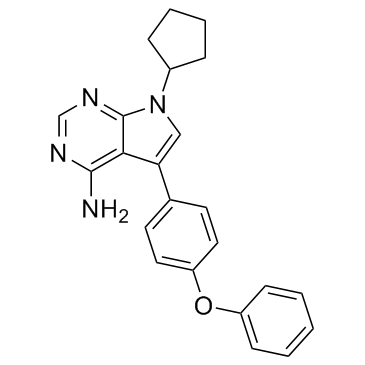| Description: |
RK-24466 (KIN 001-51) is a potent and selective Lck inhibitor; inhibits Lck (64-509) and LckCD isoforms with IC50s of less than 1 and 2 nM, respectively. |
| Target: |
IC50: <1 nM (Lck (64-509)), 2 nM (LckCD)[1] |
| In Vivo: |
RK-24466 inhibits T-cell receptor stimulated (a-CD3 mAb) IL-2 production in mice at low doses (ED50=4 mg/kg) after ip administration. However, efficacy is greatly reduced after oral administration (ED50=25 mg/kg) which is presumed to reflect poor intestinal absorption in the latter regimen. Inhibition of antigen specific T-cell immune responses is also seen for RK-24466. After administration of RK-24466 twice daily (100 mg/kg po) for 3 days during the in vivo priming phase, a 70% inhibition of IFNγ production is seen upon subsequent antigen-specific (KLH) challenge of lymphocytes from the draining lymph nodes in vitro[3]. RK-24466 suppresses the migration of VSMCs from endothelium-removed aortic rings, as well as neointima formation following rat carotid balloon injury[2]. |
| In Vitro: |
RK-24466 is selective for Lck over a range of receptor, non-receptor tyrosine kinases and seronine/threonine kinases. RK-24466 are potent inhibitors of IL2 production in Jurkat cells stimulated with anti-CD3 antibody, being at least 100-fold more potent than PP1. RK-24466 displays remarkable cellular selectivity[1]. RK-24466 significantly inhibits both VSMC proliferation and migration. RK-24466 suppresses VSMC proliferation and migration via down-regulating the protein kinase B (Akt) and extracellular signal regulated kinase (ERK) pathways, and it significantly decreases the expression of proliferating cell nuclear antigen (PCNA) and cyclin D1 and, the phosphorylation of retinoblastoma protein (pRb)[2]. |
| Cell Assay: |
To examine the concentration-dependent effect of the RK-24466, VSMCs are cultured in 10% FBS-supplemented DMEM containing either vehicle (DMSO 2%, v/v) or increasing concentrations of the RK-24466 (1 to 10 μM) for 24 h, and cellular proliferation is determined by using CCK-8[2]. |
| Animal Administration: |
Rats: For the RK-24466 treated group, RK-24466 at a final blood concentration of 5 μM is intravenously injected through femoral vein. At 14d after BI, the rats are anesthetized, and the carotid arteries are excised. The entire length of the right carotid artery is balloon injured. The left carotid artery serves as an uninjured intra-animal control. To assess the neointima formation, H&E stained section is imaged, and the intima to media thickness ratio is measured[2]. |
| References: |
[1]. Arnold LD, et al. Pyrrolo[2,3-d]pyrimidines containing an extended 5-substituent as potent and selective inhibitors of lck I. Bioorg Med Chem Lett. 2000 Oct 2;10(19):2167-70.
[2]. Seo HH, et al. 7-cyclopentyl-5-(4-phenoxyphenyl)-7H-pyrrolo[2,3-d] pyrimidin-4-ylamine inhibits the proliferation and migration of vascular smooth muscle cells by suppressing ERK and Akt pathways. Eur J Pharmacol. 2017 Mar 5;798:35-42.
[3]. Burchat AF, et al. Pyrrolo[2,3-d]pyrimidines containing an extended 5-substituent as potent and selective inhibitorsof lck II. Bioorg Med Chem Lett. 2000 Oct 2;10(19):2171-4. |






















